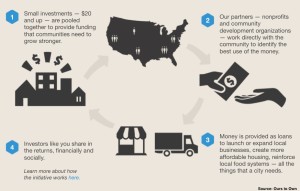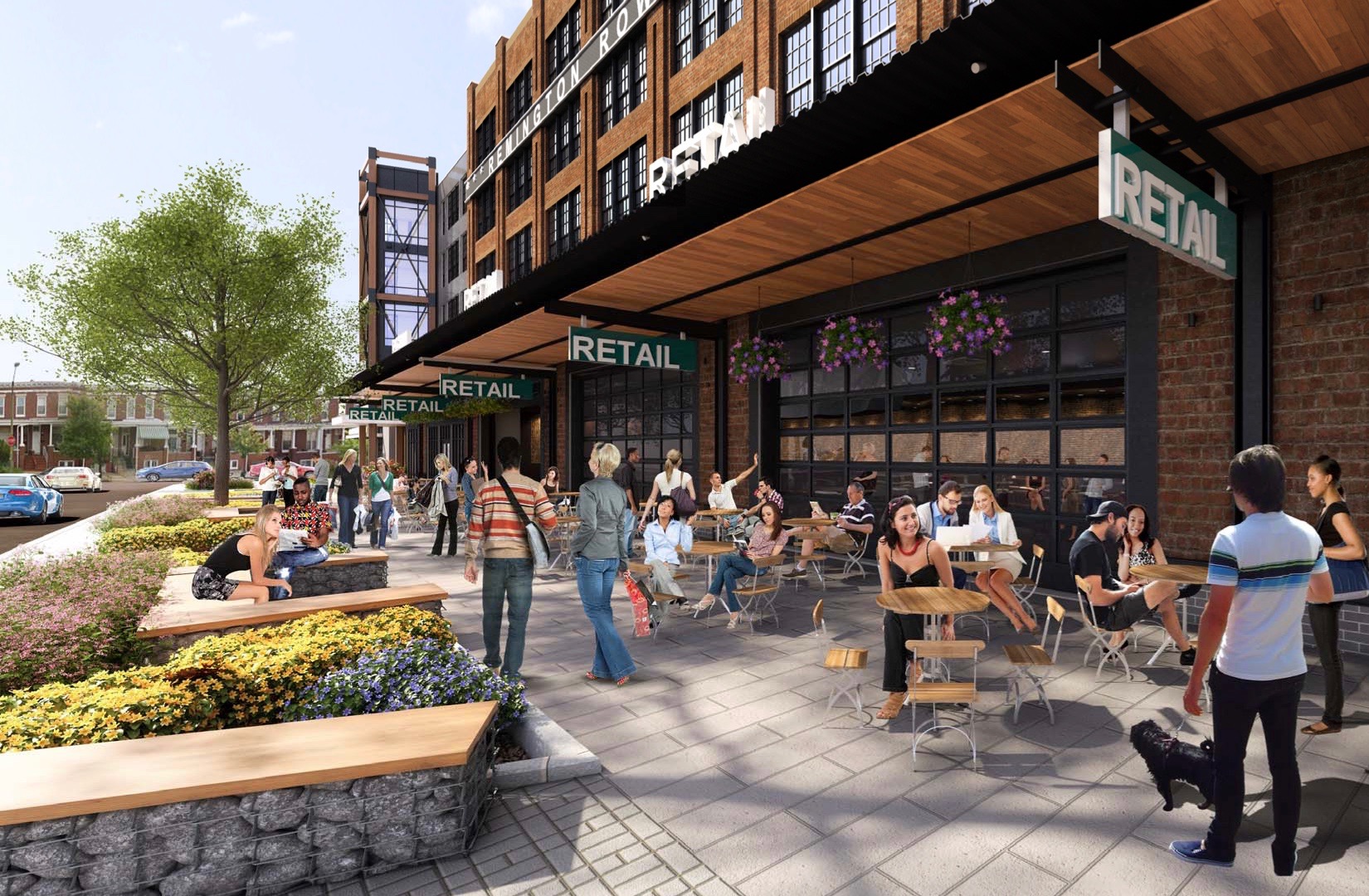Assembling the Tool Kit: Ours to Own
An unfortunate reality lies at the core of most economically challenged cities in the US– there is a desperate need for funding of infrastructure projects, yet governments and charities cannot meet the full financial need. Ours to Own, a crowdsourced investment initiative from the Calvert Foundation, arises out of this scenario.
The program offers a simple fix to the problem of vanishing funds from the government and charities. It asks residents of the very communities being invested in (or really anyone at all) to pitch forward small amounts (starting at $20) as not donations, but investments that they will earn competitive returns on. These small investments are pooled together, and in the end allow large scale impact.
Rodney Foxworth is a respected change-maker on the ground in Baltimore, one of three cities where Ours to Own is being implemented. As a social entrepreneur, nonprofit advisor, and philanthropy consultant, he has found himself in a diverse range of roles all with the aim of making a notoriously disadvantaged city great again. Besides working with Black Male Engagement, founding and co-founding Invested Impact and ImpactHub Baltimore, Rodney has taken a major role in seeing the success of Baltimore Ours to Own campaign.
We spoke to Rodney recently to learn more about his path and the rollout of Ours to Own Baltimore. Just like our previous conversation with Jeffrey Ashe, the goal of this conversation was to deconstruct a unique financial model and see what it can tell us about how African Americans across the country are engaging with entrepreneurship, and ultimately how they can better generate wealth.
What is Ours to Own?
 Let’s briefly go into more detail about the Ours to Own program and how it works. The program exists mainly in three cities (Baltimore, Twin Cities, and Denver) as well as within a small national context. The tight geographic focus is intentional. For one, all of these cities are confronted by complex development issues, grappling with how to grow in a healthy way and looking for funds to do this. On top of this, having a place-based focus allows for the program to tap into the spirit of localism and self-determination. Ours to Own is centered around the belief that residents of cities like Baltimore are actively desiring positive change in their communities, but need new ways to put their money to work.
Let’s briefly go into more detail about the Ours to Own program and how it works. The program exists mainly in three cities (Baltimore, Twin Cities, and Denver) as well as within a small national context. The tight geographic focus is intentional. For one, all of these cities are confronted by complex development issues, grappling with how to grow in a healthy way and looking for funds to do this. On top of this, having a place-based focus allows for the program to tap into the spirit of localism and self-determination. Ours to Own is centered around the belief that residents of cities like Baltimore are actively desiring positive change in their communities, but need new ways to put their money to work.
But like I said, Ours to Own is not a charity fund. It’s an investment fund, promising loaners competitive returns to that of mainstream savings accounts. The way this happens is more complex than the cleanly-designed website might lead you to believe. “Ours to Own works through the Calvert Investment Note to raise local capital to be deployed locally,” said Rodney. “I see it as a tool that can create opportunity to catalyze a community of stakeholders to develop solutions about how to best leverage the notes.”
Ours to Own has two key features to ensure its projects are successful and profitable. First to note is the strong CDFI presence within the program. These institutions, which vary from city to city, allow for the best funding targets to be identified. Along the same lines, Ours to Own requires local actors to play the role of brokers and on the ground sources of knowledge and connections. They help draw connections between deserving projects and fund dollars. In Baltimore, one of these actors is Rodney Foxworth.
“My work is grounded in economic inclusion, wealth building, and entrepreneurship … particularly for underrepresented entrepreneurs,” Rodney told me during our conversation. “Effectively what I’m doing is pulling together a pool of investors to support minority entrepreneurs in Baltimore.” It’s this very ability to pull together that allows Rodney to be so helpful with the Ours to Own campaign. Rodney sees that the reality of a place like Baltimore is that it is a city “fractured” on many levels. To ensure a successful program, it takes someone who understands these fracture lines, and who knows what it takes to repair them.
When everything comes together right, the catalytic potential of any given Ours to Own project is impressive. Out of many examples, one of the most successful case studies is Baltimore’s Remington Row. Ours to Own was able to provide a $1.5 Million loan which helped this housing, retail, and mixed space project get out the ground.
“One of the things I love about Ours to Own is its accessibility,” Jessica Norwood told me when we sat down to discuss the program and its transferability to other areas and projects. “Its online presence is really clean, straightforward.” But she emphasized the importance of recognizing elements that hide behind the curtains. She points out that “you’re running on the financial due diligence of a CDFI and their ability to find a portfolio of projects that represent a local community that you would be excited to support.” It’s hard to overstate the “money and hard work” that this relationship requires.
In order to create an Ours to Own program in a new city you need to assess how effective and well resourced the local CDFIs are. And as it is for our project, if your goal is to create infrastructure specifically for African Americans, Jessica notes that sometimes CDFIs are not set up for this. Also, in terms of cashflow, some CDFIs are better than others. In those that struggle to aggregate funds, this ends up impacting the overall viability of the projects they support. For investors this might mean a lower final return, which is critical when the difference between competitive and undesirable is 5% vs. 3%.
The other important asset that Jessica pointed towards is the broker (Rodney) on the ground who knows the community and can help focus the project. She stressed the hidden importance of establishing this stakeholder, something necessary to consider before transferring the Ours to Own methodology to a new location:
“Often types these sort of folks are under resourced. Program implementers might see the value in them, but they don’t understand why it’s important to pay someone to play this bridge building role. In my own research, people are very excited about funding the institution because you can measure this. Or they’re really interested in the entrepreneur who eventually got the money, but nobody wants to talk about the really unglamorous, very expensive role of the people who broker and bridge build.”
Jessica asks, “there’s probably a Rodney in every city, but can this person be found and then resourced?” This is one of the main questions of viability that needs to be considered before any attempt of implementing an Ours to Own type program in another setting.
Ultimately, the discussion here echoes a theme that has been brought up in almost every conversation we’ve had with financial tool builders leading up to our summit in NY next week (April 14th). When creating these types of projects you cannot overlook the value of the local–the unique blend of places, people, and culture that makes a place what it is. Jessica poignantly closed with this point during our conversation: “The way you enter something matters … if you don’t enter with with understanding of the local history and relationships, you can miss out on building something that matters for most.” For Ours to Own in Baltimore, this took the form of being able to understand how a project like Remington Row has potential achieve both financial and social good–and how a community of local investors believing in financial self-determinism can help spark such a project. Generally speaking, this same kind of awareness is necessary in every project. Development is not a proven recipe, and what works in Baltimore won’t work in Mobile, Alabama. What works for a racial majority in this country will not necessarily work for a racial minority.

